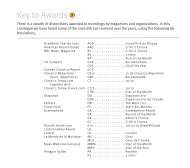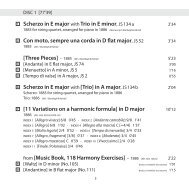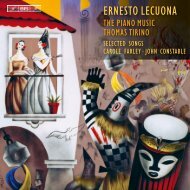MENDELSSOHN - Bis
MENDELSSOHN - Bis
MENDELSSOHN - Bis
You also want an ePaper? Increase the reach of your titles
YUMPU automatically turns print PDFs into web optimized ePapers that Google loves.
Breit kopf & Härtel: ‘I composed it in a few days, some what care lessly; despite<br />
this it has always pleased the audi ence greatly, though I have little time for it’.<br />
By contrast, Mendelssohn’s Concerto No. 2 in D minor for Piano and Orch -<br />
estra has remained obscure and is rarely heard. He wrote it in response to a com -<br />
mission from the Bir mingham Festival, and the composer himself played the solo<br />
part at its first performance on 21st September 1837. Men dels sohn continued to<br />
en joy great pop ularity in England, and the audi ence’s enthusiastic applause pre -<br />
vent ed him from sitting down to perform for some min utes. Even though this<br />
con certo is in fact a more profound work, Mendels sohn’s youthful spark was not<br />
evident enough for it to claim a position in the standard reper toire.<br />
Disc 10 · Concerto for Violin and Piano; Concert Pieces<br />
On 6th May 1823, the fourteen-year-old Felix Men delssohn com pleted a Con -<br />
certo in D minor for Vio lin, Piano and Strings. It was a large-scale work lasting<br />
some 35 minutes, and it shows a sure sense of form as well as containing much<br />
virtuoso writing. The young composer had certainly dev el oped signi ficantly since<br />
the previous year, when he wrote a violin con certo in the same key. At that time<br />
he was already an extremely productive com pos er, developing im pres sive in -<br />
sights and gathering wide experi ence. On this occasion, too, he took clas sical<br />
com posers such as Haydn and Mozart as his models, but early Ro manticism can<br />
certainly also be found in this work. The orchestral writing is relatively straight -<br />
forward but it is also highly ef fective.<br />
The concerto opens with embellishments in a Bach-like counterpoint, from<br />
which a romantic appassionato grows, counterbalanced by a lyrical second<br />
theme. The interplay between the two solo ists is surprisingly mature; each of<br />
them also has a fine selection of individual challenges, and is per mitted to shine<br />
alongside the orchestra. In the slow move ment the orchestra is kept in the back -<br />
41








